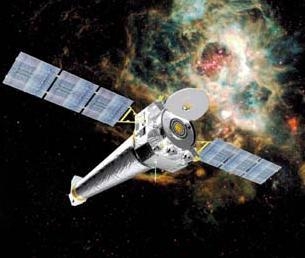By studying
different astrophysical aspects and manifestations
compact objects (neutron stars, pulsars, black holes) across the entire electromagnetic spectrum
we are trying to answer fundamental questions not only about these bizarre objects but also about related physical processes such as cosmic ray production, particle acceleration,
compact binary physics, accretion, and supernova remnant (SNR) evolution. We employ machine-learning and advanced statistical methods to
learn about the properties of populations
of Galactic X-ray sources (including pulsars, black holes, microquasars, X-ray binaries).
Neutron stars are collapsed stars whose surfaces can be hot enough to emit radiation in ultraviolet and X-rays.
In addition many neutron stars manifest themselves as pulsars - objects that emit short intense bursts of radio waves, x-rays,
or visible electromagnetic radiation
at regular intervals. Due to the extreme conditions in the neutron star interiors, these objects can be used
as natural laboratories for studying the poorly understood properties of the superdense,
strongly magnetized, superconducting matter. Such conditions can never be reproduced in
Earth laboratories and therefore studying neutron stars provides the only way to learn about
the nuclear reactions and interactions of the elementary particles under these extreme conditions. This information is of fundamental importance for particle and quantum field physics.
Studying pulsar winds allows one to understand the complicated PWN morphologies, elucidate the dynamics of relativistic magnetized outflows and their interaction with the ambient
medium (e.g., host SNR), and learn about particle acceleration in magnetized relativistic plasmas. X-ray and
optical observations of neutron stars provide valuable diagnostics of all these processes.
Microquasars are the most extreme manifestations of stellar black holes. In these system (which are in many respects analogues to their supermassive counterparts in active galactic nuclei)
matter pulled from a massive companion star falls into a black hole or onto a neutron star. In this proccess the matter heats up to very high temperatures and emits intense X-ray radiation.
Due to the rapid rotation of the compact object s fraction of infalling matter is being ejected from the system along the compact object spin axis leading to formation of jets
whose nonthermal emission can be seen througout a wide range of frequencies. Some microquasars are also emit very high energy (VHE) radiation in GeV and TeV bands. The exact mechanism responsible for the VHE radiation is has not yet been established with several
possibilitites being currently explored. We are currently performing a detailed study of LS 5039 and HESS J0632+057 using data from NuStar, Suzaku, Chandra, XMM-Newton, and Swift.
Supernova remnants (SNRs) that are produced in explosions of massive stars are expected to host compact objects (in most cases). We are
classifying X-ray sources within the SNRs and performing census SNRs observed in X-rays to find these compact objects and understand the connection between the compact
object type and the properties the massive progenitor star.


Research Areas:
Astrophysics of Compact Objects:
- Pulsars winds and pulsar-wind nebulae;
- Thermal emission from neutron stars;
- Extended TeV sources as relic pulsar-wind nebulae;
- High-mass binaries with neutron stars and black holes (gamma-ray binaries);
- Galactic surveys in X-rays;
- Modeling of relativistic magnetized outflows;
- Modeling observational signatures from pulsars with shut-off pair cascades;
- Modeling properties of emission coming from the vicinity of a BHs.
Machine-learning and astrostatistics applications to classification and weak signal detection:
- Multiwavelength classification of unidentified X-ray and gamma-ray sources;
- Detection of faint extended X-ray sources in Chandra X-ray Observatory images;
- Searches for compact objects in stellar clusters observed by Chandra X-ray Observatory;
- Detection of nearby, relic neutron stars, transient magnetars and isolated black holes;
- Ultra-short transient detection in HST data;
- Searching for periodic and quasi-periodic signals in GRB data and X-ray binaries.
Graduate students and postdocs trained in Kargaltsev's group (more recent first):
- Steven Chen, GW Physics PhD student
- Hui Yang, GW Physics PhD student
- Dr. Igor Volkov, postdoctoral scientist
- Dr. Noel Klingler (PhD 2018), former GW Physics graduate student, now postdoc in the Swift Team at Pennsylvania State University, US
- Dr. Jeremy Hare (PhD 2018), former GW Physics graduate student, now NASA Postdoctoral Fellow at Goddard Space Flight Center, US
- Dr. Blagoy Rangelov (2013-2016), former GW Physics postdoc, now Assistant Professor at Texas State University, US
- Dr. Martin Durant (2008-2012), former UF Astronomy postdoc, now Data Scientist and software engineer at Continuum Analytics
Present and former collaborators (more recent first, the list is always incomplete):
- George Pavlov, Pennsylvania State University, US
- Roger Romani, Stanford University, US
- Pat Slane , Harvard University (CfA), US
- Chryssa Kouveliotou, George Washington University, US
- George Younes, NASA, GSFC
- Thomas Pannuti, Morehead State University, US
- Brian Williams, STScI, US
- Tatiyana Apanasovich , George Washington University, US
- Kalvir Dhuga, George Washington University, US
- Gordon Garmire, Pennsylvania State University, US
- Sangwook Park , University of Texas Arlington, US
- Andrei Bykov , Ioffe Physico-Technical Institute, Russia
- Zdenka Misanovic, Monash University, Australia
- Roberto Mignani, Kepler Institute of Astronomy, Poland
- Koji Mori, University of Miyazaki, Japan
Our group also includes several graduate and undergradue students working on various
projects at George Washington University and Penn State University.
We welcome new students and postdocs willing to work with us in these exiting areas of High-Energy Astrophysics!
Our research is supported by vigorous observing program carried out on nearly all major space observatories (Chandra,
XMM-Newton, NuStar, Suzaku, Fermi, HST, Spitzer) as well as Atacama Large Millimeter/submillimeter Array (Chile),
Jansky Very Large Array (New Mexico, US), and Australia Telescope Compact Array. Dr. Kargaltsev is also an associate member of VERITAS collaboration.

Find out more:
Recent Developments and Selected Publications













